The A300, A350, A750?
In mid 2007, rumours of a 14.8 megapixel Sony sensor came from the usual Far Eastern ‘inside’ sources. As a full-frame Alpha model (the so-called 900) had been previewed at PMA 2007, it was possible this megapixel count related to full frame, or near-full frame. It now looks as if it may have been a leak of development for currently rumoured 14.2 megapixel (active) Alpha 350, which is an APS-C sensor camera.
The Alpha 300 and 350 may also be a part-explanation for the appearance on a genuine Sony dealer website in Luxembourg of a model called Alpha 200 Ultra, though the specifications shown on that webpage appear to have been clipped from other models. The 300/350 are due to appear shortly and has Live View, though the rear display does not seem to be full articulated. It won’t aim forwards for self portraits or hinge for vertical compositions at ground level, unless some details are missing from prototypes seen in photographs.

These images show a roughly A200-sized camera with small modifications. The button at the top right hand end of the rear is marked with a symbol which indicates ‘expand’ or zoom with a screen pictogram, and can be guessed as a focusing magnification button. There is an additional switch on the top plate for switching between OVF and Live View, but this marking (OVF) refers specifically to the Alpha 350 – see below. It is possible the Alpha 300 and 350 use different viewing methods for the eye-level viewfinder. But it’s more likely they have different sensors, and the same overall functions. As the information emerges, it becomes more and more certain that they are not EVIL/EVF models, or off-sensor live view models.
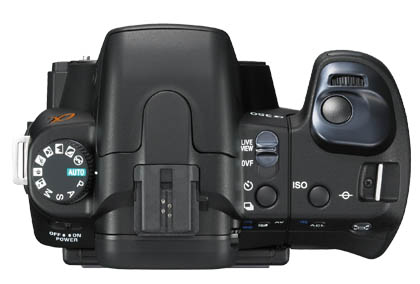
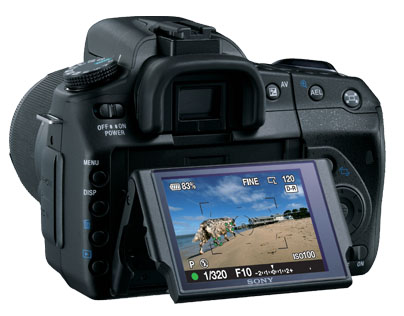
The controversy at the moment is whether Sony has used a Live View capable imaging sensor – like the IMX021 CMOS sensor of the Alpha 700 – or stuck with the A200’s 10.2 megapixel CCD which is not supposed to be able to support Live View. The apparent position of (green) live focusing indicators on the shot of the Alpha 350 above might hint that it focuses off the sensor. However, you will note that the markings found on the standard focusing screen are present. There is no reason for these to be shown on a Live View screen as they have no function. This are almost certainly a sign that the live view is actually in-prism, and we are seeing a view of the focusing screen, not an image from the main sensor. This system is an advanced Zigview built into the camera body.
The theories or rumours have been as follows:
1) The camera uses the Alpha 700 CMOS sensor and implements Live View in the same way as the Nikon D300 (below, and identical to the Sony assembly).
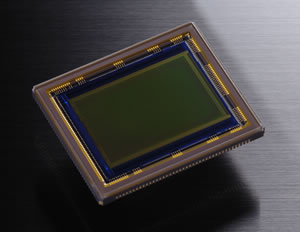
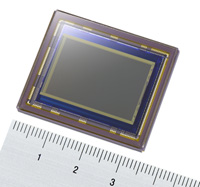
2) The camera uses the 1.7X factor Live View CMOS sensor from the Sony Cybershot DSC R-1.
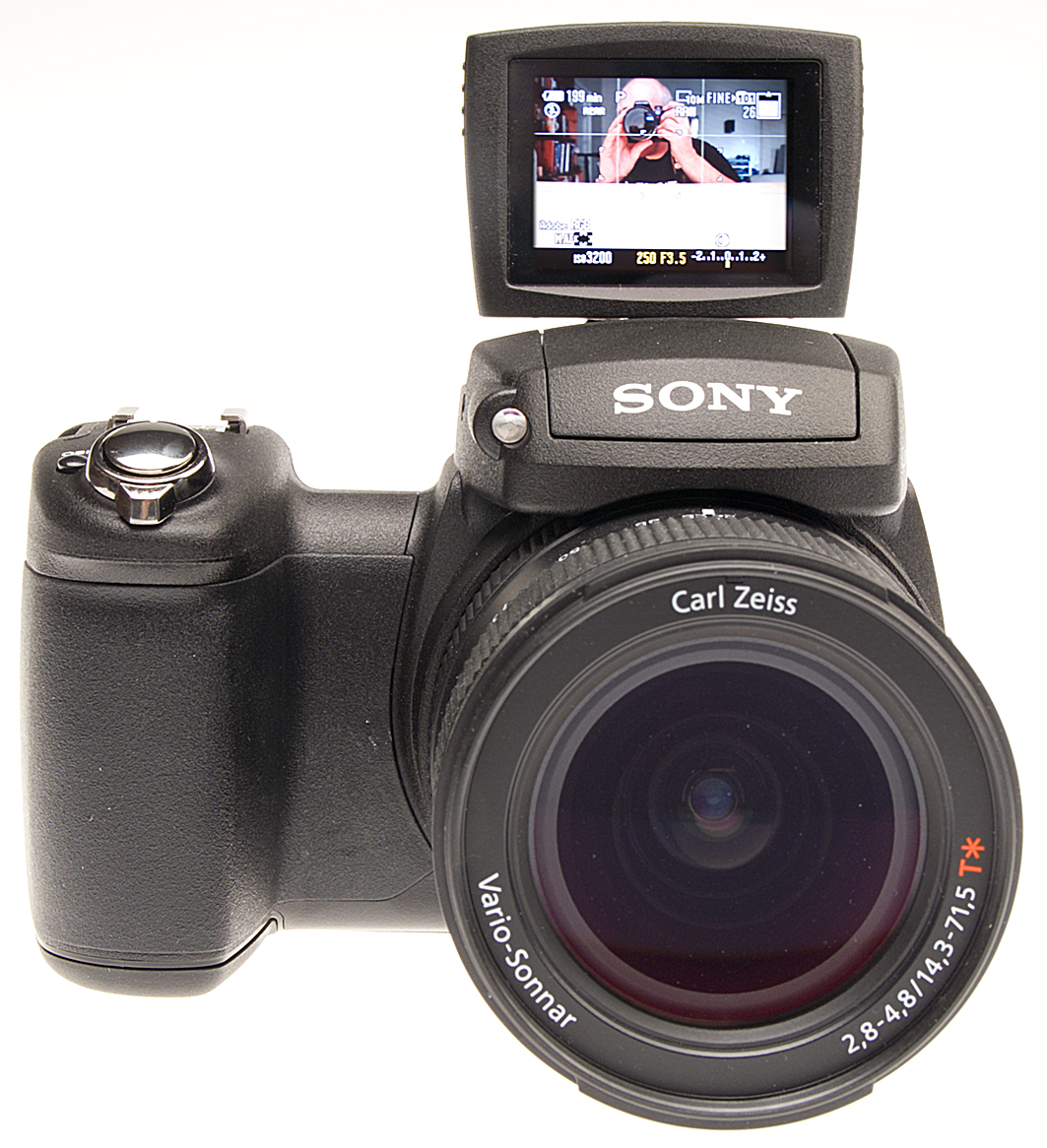
3) The camera uses a sensor which is identical the R-1 in structure, expanded to 1.5X factor, which will make it similar in pixel count to the Alpha 700 but with a modest frame rate.
4) There is a second complete full sized sensor which swings over to replace the focusing screen and receive the image from the SLR mirror, handling both autofocus and viewing. This rumour is one of the most solid in terms of rumourmonger confidence, but it sounds impractical. It is not possible to flip a sensor on top of the focus screen, it would have to be in the same exact plane, which means the focus screen moving out of the way. Sony is also against mechanical complexity in camera design. They have already said the Konica Minolta 7D was too complex and had too many moving parts. It’s hard to see them opting for a complex mechanical system which would involve multiple collimation and calibration issues. (This rumour is so far fetched it’s easily discounted).
5) The Live View sensor may be in the prism housing, as on the Olympus E-300, and separate from the shooting sensor. This seems more likely as Sony has access to low-cost own manufacture sensors or many types and sizes and could design a secondary viewing system easily. I favour the idea of a sensor incorporated into an internal eyepiece shutter, so it moves into place behind the ocular. This would be mechanical, but collimation would not be mission-critical. The design of the flash unit on the A300/350 allows enough space for such a sensor, and the image of the camera previewing a scene confirms that this is probably how they work. (This rumour appears to be correct).
6) A full size secondary sensor could be placed in the mirror box well (the bottom of the darkchamber) where the AF sensors normally live. By inverting the mirror, so it directed the image at the bottom of the camera instead of up towards the focus screen, such a sensor could be made to provide a live view with focusing, and a ‘normal’ SLR action when shooting (the mirror would still flip). It is not impossible to design a mirror mechanism to work this way, but it’s a bit complex and expensive. Also, a sensor in the darkchamber base would need a covering shutter when not in use and would prevent normal AF modules from sharing that space. It is possible that the secondary AF mirror could focus on such a sensor, making it handle all AF even when Live View is not active, but the penalty would be very slow AF.
7) The A300 may look like a DSLR, but is actually an EVF camera. The rumour about the second sensor replacing the focus screen is a garbled understanding of a second image display LCD (organic) screen replacing the focusing screen, permanently, so the view through the finder is electronic not optical. But see above; the second sensor rumour may just be a bad interpretation of the in-prism system. This seems to me most like a Sony electronically engineered solution to creating a more reliable type of camera – the hoped-for DSC R-1 with Alpha mount lenses. Also, such a camera would need a completely different TTL flash protocol. Sony has just introduced a new flash, the HVL-42AM:
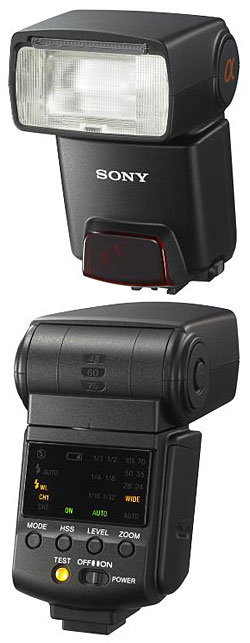
It would not be necessary for any additional controls to be visible on the flash, just for the communication with the camera to identify correctly the Live View (the flash shoe is actually a serial interface, not a ‘make and break’ contact like the regular ISO shoe). Before a Live View camera could be launched, improved flash compatibility would be essential. While the older Minolta flash units worked in a fashion on the Konica Minolta Dimage 7/A series of EVF-zoom cameras, the limitations involved would put off DSLR buyers. The existing 56 and 36 models are identical to the old KM models in communication. The new 42 model is almost certainly forward compatible with unnannounced models of DSLR. But that may have nothing to do with the current version of Live View.
Again, it may. If you have a Live View sensor aimed at the focusing screen, a pre-flash is going to hit this directly. Maybe the Live View sensor can measure flash by temporarily turning off and changing mode. Certainly, you would not want the screen suddenly washing out with the effect of the pre-flash. It will be interesting to see what they have done.
I have no inside knowledge on this, and I am not revealing details. This is speculation based on some rumours and some common sense.
The Alpha 350
It is known, now, that the Alpha 350 will have a 14.2 active megapixel sensor to compete with the Pentax K20D. The body appears identical to the 300 and has the same articulated viewing screen, and the pictures which have reached the net from Sony’s sites are labelled 350 not 300 in their filenames. I thought there might be two types of Live View, but it seems almost certain the Sony Live View is similar to the Olympus E-330, just more up to date, and only the in-prism part. Sorry, folks, no live feed from the main sensor – I’ll bet on that.
The A350 will have a prism finder (or porroprism hollow mirror type ) and conventional fast AF-module based autofocus with instant return mirror and the usual design features of any DSLR. Live view will be combined with far faster operation and focusing than is possible with the current Canon, Nikon and Pentax designs.
The Alpha 300
Would seem to be exactly the same body but with a 10.2 megapixel CCD sensor.
The Alpha 750, 800, 650, or possibly the 666…
Got you! This is pure speculation. If Live View is as essential for the market as it seems to be – despite the fact that the only time I’ve used Live View is for articles to demonstrate what Live View does – then the Alpha 700 must acquire it. If megapixel count is vital for success, and Pentax and Samsung have 14.x megapixels, then Sony must also have 14.x or more in their 700-level DSLR. Assuming the A350 image quality is OK, an Alpha 700 body fitted with the 14.2 megapixel sensor and Live View seems highly likely before 2009. As to what it might be numbered, you’d better consult the bones or read the tea-leaves for that.
The Alpha 900
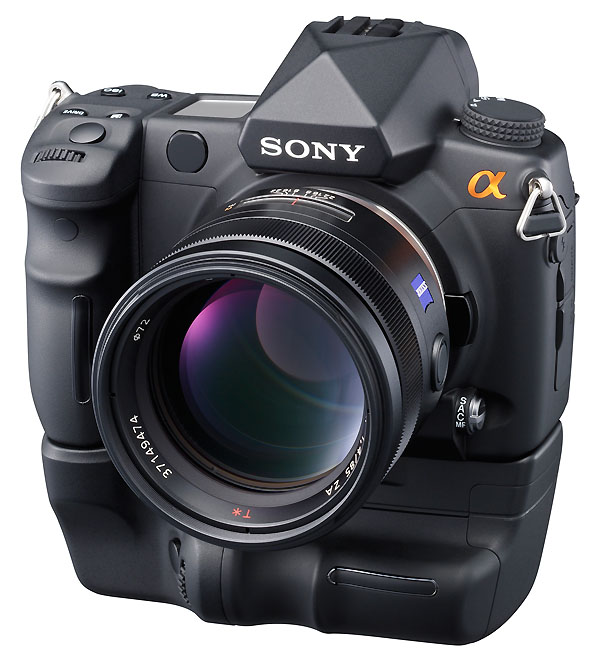
It’s gone awfully quiet round here, hasn’t it? The lenses are being rolled out. It’s coming. PMA is imminent. photokina is September. Pigs can already fly. Never seen a copper chopper?
– David Kilpatrick

Good piece, DK.
A little birdie whispered the following to me:
“A101 no optical viewfinder
A200
A300 better A200
A500 budget A700
A700
A800 budget A900
A900
A1000 true pro
That is 8 cameras, not 5, 3 will be FF, but it is a very long term plan.”
I dunno about the info, other that it is “inside” info. Maybe inside the round file??? I dunno, it could be just cra*… Anyway, the numbers are not quite correct as we already see the 350 on it’s way!
Well, I now have about 400 images from the A100 and A700 up in the galleries at http://www.sonolta.com/sony-photos/main.php so anyone that wants to take a look at some real world Sony Alpha DSLR performance feel free to check the images and the 100% crops.
Again, nice piece, DK.
-Sonolta
http://www.sonolta.com
Should be interesting David, thanks for the breakdown 🙂
Carl